
M A D E . O F . W A L K I N G
![]()
On this page are the contributions of Stefaan van Biesen and Annemie Mestdagh [as members of the Milena principle] for the Made of Walkings events [Delphi Greece 2017, La Romieu France 2017, Neo Chorio Akamas Cyprus 2018, Minho University Guimaraes Portugal 2018 and Prespes Greece 2019.
Made of Walking is organized by the Milena principle, with a series of screenings, workshops and conferences relating to walking, focussing on dialogues between performance, arts, literature and new media, inviting students, (young) artists, writers, walkers, performers, musicians and composers, sound designers, new media artist, developers, teachers, experts and scientists of different fields, to share their experiences. Projects/performances are meant for following outdoor venues. Made of Walking is curated by Geert Vermeire/the Milena principle. assisted by Annemie Mestdagh/the Milena principle & Stefaan van Biesen/the Milena principle.
![]()
[The Relocated Eye] Sound Walk September ⋈ Walk . Listen . Create [UK London] 2020.
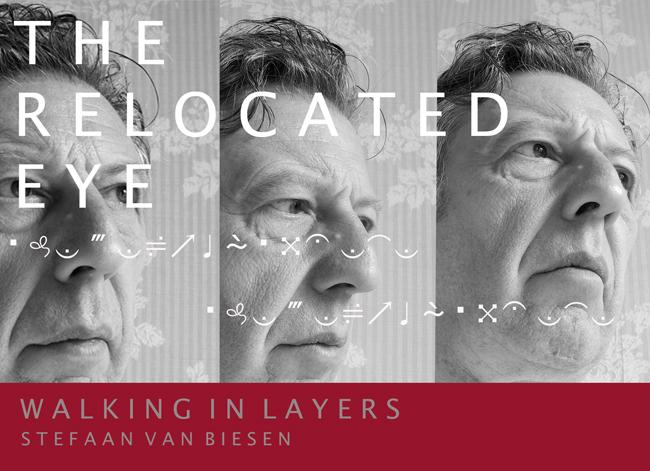
The Relocated Eye is a project that encourages the walker to approach or to discover a particular place from different perspectives and points of view. It is a performative walk that you can do alone or in a group. And the idea is to move your point of view several times in one particular place that you have chosen. So it can be in a landscape or in an urban environment.
Your eye moves, your body takes up different positions so that you start looking at the place from different points of view and try to understand it better. Your body is an ever-changing center from which you will observe and visualize the location. And with the pleasure of really 'sensing’ the city (or natural place) and being aware of it. The city with its own urban 'body', with all its emotional and functional 'organs'. It is great to deal with a place in a creative and relational way, based on these personal observations.
Click here to read about the project The Relocated Eye > >
Read about: Walk . Listen . Create [walking artists] > >
![]()
2019 > >
![]()
[Tracing a Walk, Ostend 1936] Square 42 ⋈ Prinses Clementinaplein 42 ⋈ Ostend Belgium.
18 -19-20.10.2019 'Buren bij kunstenaars'.
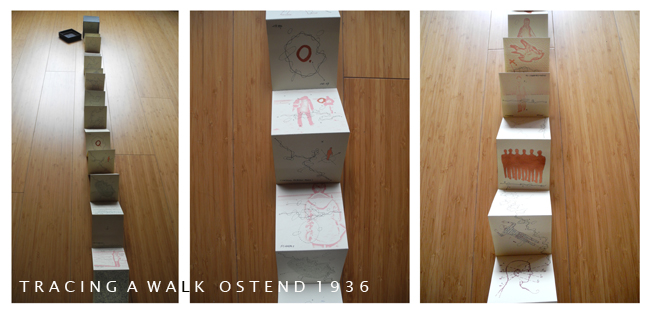
The theme of this portable nomadic museum is the group of refugee writers, those who were stranded in Ostend in 1936, fleeing the Nazi regime. Joseph Roth en Irmgard Keun, Egon Erwin Kisch en Gisela, Stefan Zweig en Lotte Altmann, Hermann Kesten, Ernst Toller en Christiane Grauthoff, Arthur Koestler, Willi Münzenberg, Otto Katz, Etkar André, etc...
At that time my mother and my grandparents also stayed in Ostend. It is therefore a mix of family history and world events. Two stories that cross each other, unintentionally.
![]()
Made of Walking (VI) Sound and Ecology.
Sound Walk Sunday, global community event September 01.09.2019
Location: Hof Ter Saksen Beveren Belgium.
http://www.museumofwalking.org.uk/our-events/sound-walk-sunday/
see: https://www.museumofwalking.org.uk/events/wander-weed-session-2/
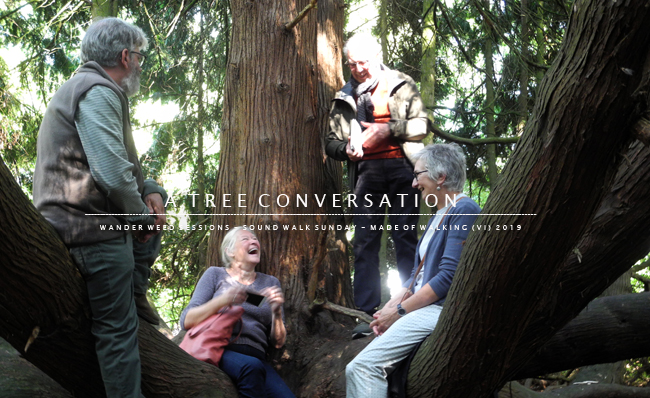
The museum of walks is a demanding party for various like-minded artists and walkers to have an artistic [sound] project take place on the same day. For this crossing border project, Stefaan van Biesen and Annemie Mestdagh are doing a Wander Weed session [Plant(e)scape Made of Walking IV Akamas Cyprus 2018, The Walking Body Minho University Guimaraes Portugal 2019], in Beveren Belgium. People are invited to a performative walk that is a mix of a lecture, a conversation and an exercise. The theme of this event is our relationship with plants and plant intelligence.
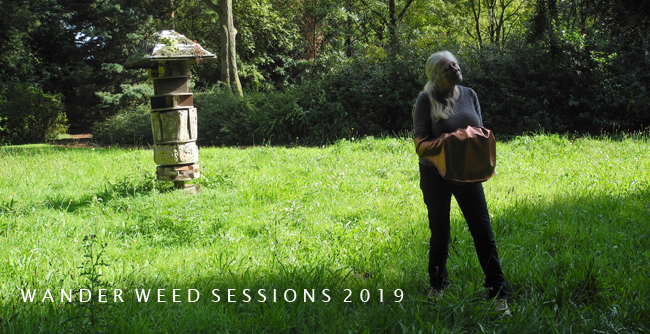
Sound Walk Sunday 2019 will take place on Sunday 1st September in the UK [London], as part of a week-long festival of sound walking events and performances beginning on the 1st September, globally celebrating outdoor audio, geo-located, immersive performances, listening walks and sound walks. In the coming months, we will be issuing calls for walking pieces that have been produced since Sound Walk Sunday 2017, and for new work to be premiered on Sound Walk Sunday 2019.
Sound Walk Sunday 2017 was inaugurated at the Made of Walking International Gathering at La Romieu, in south west France on the 27 August, 2017. We are delighted to renew our relationship with Made of Walking for Sound Walk Sunday 2019.
http://www.museumofwalking.org.uk/our-events/sound-walk-sunday/
![]()
LISTEN Festival, a summer of sound art, Frome (UK) Sound Walk Sunday 01.09.2019.
LISTEN: Utopia, a drift for dancers and silent walkers. A silent walking and movement performance directed by Geert Vermeire conceived on the “Utopia” book by Stefaan van Biesen. Dancers: Soo Wright, Karen Burnett and Jackie Adkins
Dancers move around – in silence- through the city, with no other intention then to get lost, with a book, inspired by Thomas More’s Utopia, but containing in this version only one word and in a format that challenges the very idea of a book.
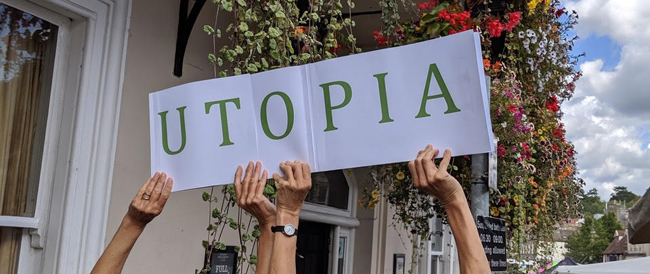
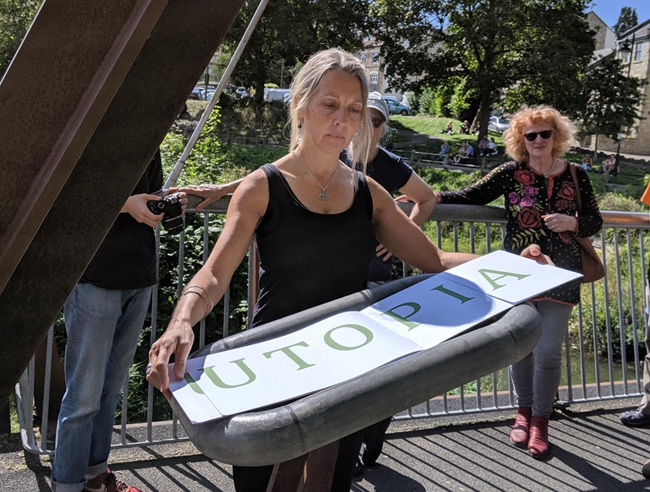
It is a book that resembles a walk – a movement, it is not linear, it opens from different angles, it has pages folded in pages, you can open and browse through it in different directions, actually it is not a book to be read, it is a book to be shared spontaneously between the silent dancers/walkers, carried around and to be opened on places that come towards the performers/walkers, symbolically opening the places, inviting to read the place, the walker and the moment in which they stand. The public is invited to join in with the dancers.
A silent walking and movement performance directed by Geert Vermeire, conceived on the “Utopia” book by Stefaan van Biesen, together forming an artistic walking duo since 2001 developing in a collaborative practice called the Milena principle.
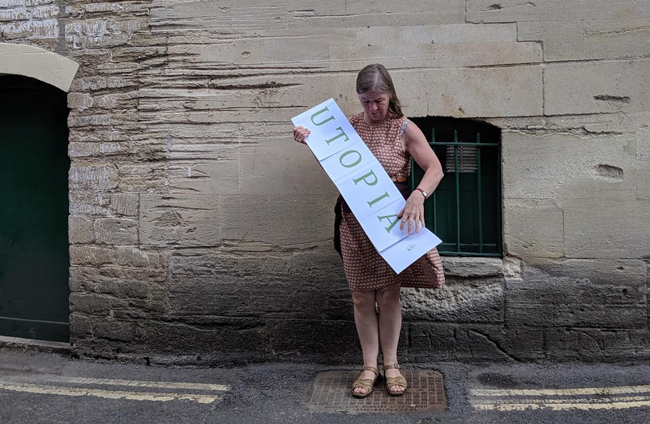
Photos by Mel Day.
2 Bridge Street, Frome a drift for dancers and silent walkers – with Geert Vermeire.
A silent walk at the LISTEN, A Season of Sound Art, Frome (UK).
Dancers move around – in silence- through the city, with no other intention then to get lost, with a book, inspired by Thomas More’s Utopia, but containing in this version only one word and in a format that challenges the very idea of a book.
As a duo of walkers, they invite guest artists and the public to perform with them in a continuous series of walking performances in contemporary cities around the world. Interview video. Utopia is a performative silent walk, adapted to each place and shaped by the participating dancers/walkers, and organized since 2016 in Braga (Portugal), Nicosia (Cyprus) 2017, Brussels (Belgium) 2017, Brasilia (Brazil) 2018, New York (USA) 2017/2018, Athens (Greece) 2018, Queens 2018 (New York USA), Ypres (Belgium) 2019.
The walk goes along with an Utopia soundscape, called ‘Hythlodaeus 2015’ composed out of the poem ‘Unfolding the City’ by Geert Vermeire and ‘Siren’ by Stefaan van Biesen. Voice and composition by Stefaan van Biesen. Field recordings by Geert Vermeire and Stefaan van Biesen. The name of the sound piece is inspired by the explorer of Utopia, originated during field recordings of walks of the artists in Venice and in Antwerp where Thomas More wrote his book. This digital material was composed to a soundscape for the Utopia sound project for Cities and Memory.
![]()
Made of Walking (V) walking bodies 2019.
Walking encounters/conference in Prespes - Greece, July 1-7 - 2019
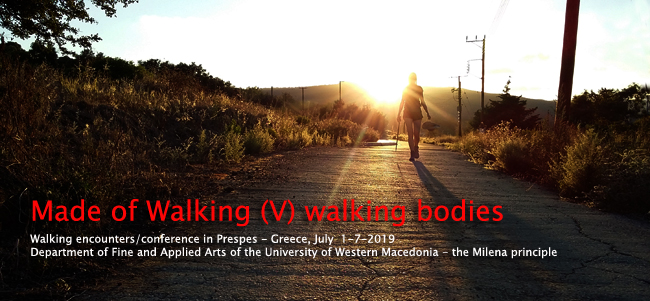
Made of Walking (V) will be hosted by the Department of Fine and Applied Arts of the University of Western Macedonia in Greece and takes place as a joint event with the International Encounters/Conference “WALKING PRACTICES/WALKING ART/WALKING BODIES”. The International Encounters/Conference will be held in the Prespes area of Greece, an unique natural environment with two lakes (Megali Prespa and Mikri Prespa) and a perturbing history of war and displacement for almost 50 years the 20th century, it is still a place of passage today and divided by borders with Albania and FYROM (Macedonia).
The theme of “Walking bodies” refers explicitly to walking together and to groups on the move, embodiment, the nomadic process, migration, the concept of home.
Artists and walking creatives are invited to participate to a residency of a week (arrival in the village of Parades, to create an in individual project open for participation or group project involving walking exploration of the Prespes area. An exhibition with the ongoing results of these walking explorations will be realised in the new Byzantine Museum of Agios Germanos in Prespes, and will travel afterwards as a nomadic exhibition worldwide. The residency will be concluded with a three day international conference (5-7 July) in the nearby village of Lemos about walking bodies and walking arts today in general.
The encounters and exhibition are coordinated/curated by Geert Vermeire and Yannis Ziogas, rector of the Department of Arts of the University of Western Macedonia. The event will take shape in collaboration with a global scientific/artistic committee. Artists and all walking creatives are invited to apply for the residency and/or to present their work at the conference.
Arrival for the residency June 28th to Sunday June 30th till July 7th. Arrival for the conference latest afternoon July 4th. Also attendees are welcome to participate.
Registration is open from now on. Online info group sessions about the region will be organised monthly for artists/creatives desiring to prepare a specific walking project for the area.
For students limited free accomodation is available in the dormitory of the School of Fine Arts. Free camping facilities wiil be offered in the garden of the school and at the shore of the lake. Further accommodation (to be paid by the participants) available in guest rooms and hotels for prices starting at 25 euros/individual room/night. Flights to Thessaloniki and Athens, further transportation by bus/train.
More information and/or your expression of interest via personal message themilenaprinciple@gmail.com
![]()
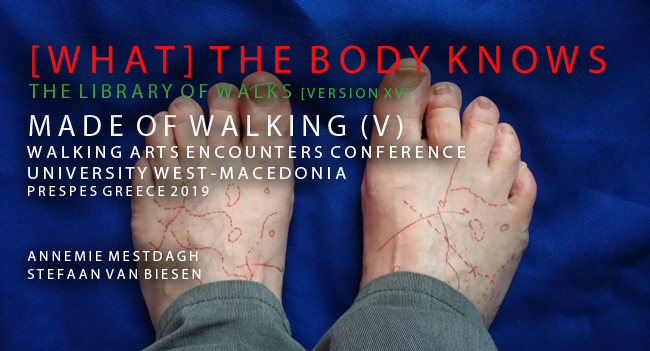
[Made of Walking (V) Walking Bodies] Walking Arts Encounters Conference Prespes Greece.
30.06 > 07.07.2019.
Video: this performative walk '(What) The Body Knows / The Blue Parade'' in the village of Psarades at Prespes is part of the Library of Walks that has been started by Stefaan van Biesen since 1990. From this ongoing process various applications grew, realized in Europe and Brasilia in collaboration with curator-writer Geert Vermeire. For Made Of Walking (V) in Prespes 2019, Stefaan van Biesen & Annemie Mestdagh, designed a portable nomadic library that is carried by a group of participants:
Walkers of the group: Yannis Ziogas, Natacha Antão Moutinho, Miguel Bandeira Duarte, Rosie Montford, Anna Villas Boas, Geert Vermeire, Chistopher Kaczmar, Marie-Anne Lerjen, Kristina Borg, Katerina Paisi, Juana Miranda, Raffaella Zammit, Lucia Masu, Emanuelle Klafiger, Ienke Kastelein, Caterina Giansiracusa.
Camera: Annemie Mestdagh & Stefaan van Biesen 2019. Time: 10:38.
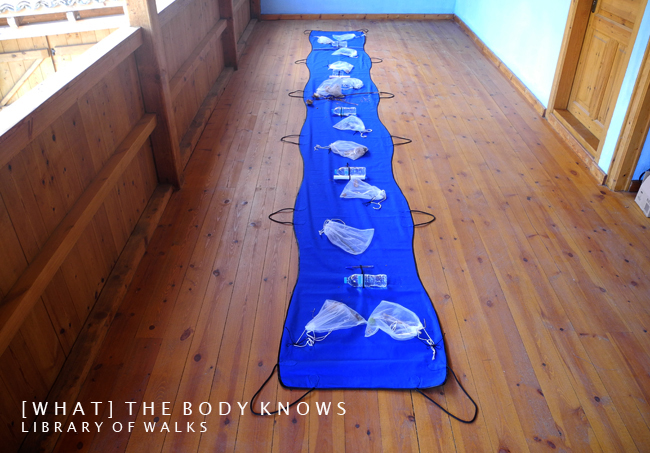
Photo: presentation of the prop and collected artefacts during '[What] The Body Knows / The Blue Parade' at the exhibition at the Byzantine Museum Of Agios Germanos at Prespes Greece 2019.
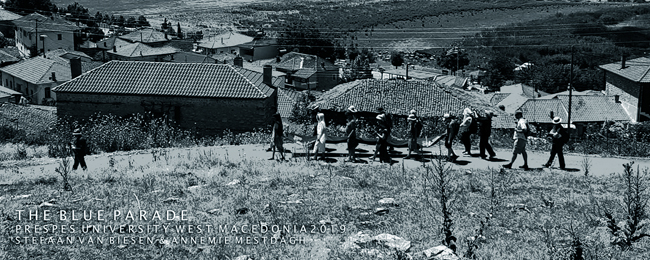
This performative walk '(What) The Body Knows / The Blue Parade'' in the village of Psarades at Prespes is part of the Library of Walks that has been started by Stefaan van Biesen since 1990. From this ongoing process various applications grew, realized in Europe and Brasilia in collaboration with curator-writer Geert Vermeire. For Made Of Walking (V) in Prespes 2019, Stefaan van Biesen & Annemie Mestdagh, designed a portable nomadic library that is carried by a group of participants:
Walkers of the group: Yannis Ziogas, Natacha Antão Moutinho, Miguel Bandeira Duarte, Rosie Montford, Anna Villas Boas, Geert Vermeire, Chistopher Kaczmar, Marie-Anne Lerjen, Kristina Borg, Katerina Paisi, Juana Miranda, Raffaella Zammit, Lucia Masu, Emanuelle Klafiger, Ienke Kastelein, Caterina Giansiracusa.

The carriers become the artwork. In this way, a mental and energetic field becomes a space specific practice. They feel their togetherness and become aware of each other's physical presence, through the object/prop that they carry together and that is functioning as a 'conductor'. During walking (and breaks), they are asked to explore the surroundings with an observing alertness and to absorb the scenery.

People carrying a portable library. The slightly meandering, streamlined shape of the ultramarine blue canvas, (in ancient Greece there was no name for the colour 'blue') *1.), refers to the nearby Little Prespa lake. Also a link to the fate of refugees. While observing, participants are asked to collect items they notice on their way in the environment nearby, small significant artifacts. The pieces can be put in pet bottles (or later in glass jars), which are attached to the blue canvas. This gives the walk a ritual dimension in which a collection is created that is representative of the biotope where the action takes place. This way the natural and social identity of a place is archived, documented.

Being together in silence, carried away by a human energetic stream, walking as a sensitive experience, must lead to a collective act that sensitively reinforces the walk.
The project of Made of Walking (V) on Kozani TV.
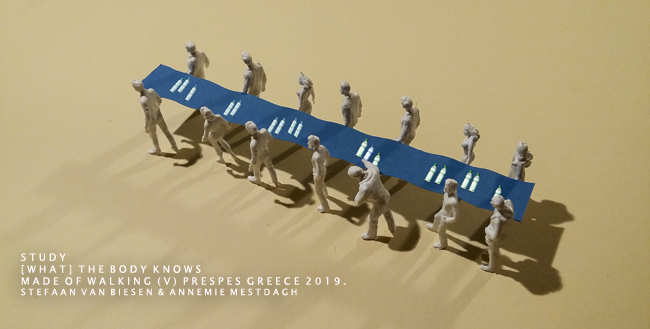
![]()
Walking Talking interview by Andrew Stuck [Museum of Walking London UK] 2019.

[Talking Walking] Made of Walking ⋈ La Romieu France 27.08 > 01.09.2017.
Delighted to say that Andrew Stuck [Museum of Walks London Uk] has got around in 2019 to editing the Talking Walking interview with me in the summer of 2017 in La Romieu during Made of Walking (III). A pod cast made by Andrew
during a walk with him. A walking talk about work and art in relation to my 'Library of Walks' and 'Letters to a Tree'. Listen here:
https://www.talkingwalking.net/stefaan-van-biesen-talking-walking/
2018 > >
![]()
The Walking Body. School of Architecture [Minho University] Guimaraes Portugal 15.10. > 19.10.2018.
The walking body A week of conferences, workshops and performances about walking and arts, open to the students and the public are planned in Guimarães and prepare an internation gathering Made of Walking in the Minho landscape of North Portugal later in 2019. The project is hosted by Lab2PT and EAUM Licenciatura em Artes Visuais (School of Architecture - Visual Arts) of the University of Minho and in partnership with the art collective The Space Transcribers and the Museum Nogueira da Silva.
It prepares collaborations between University of Western Macedonia - School of Fine Arts, the University of Wales - Arts and Performance Dept and the School of Architecture - Visual Arts of the University of Minho in a contemporary translation of the rural and natural landscapes throught the body and site specific arts, within the emotions and nomadic movements that define our actual anthropocene world, through questions that artists may rise and answers that they may have.
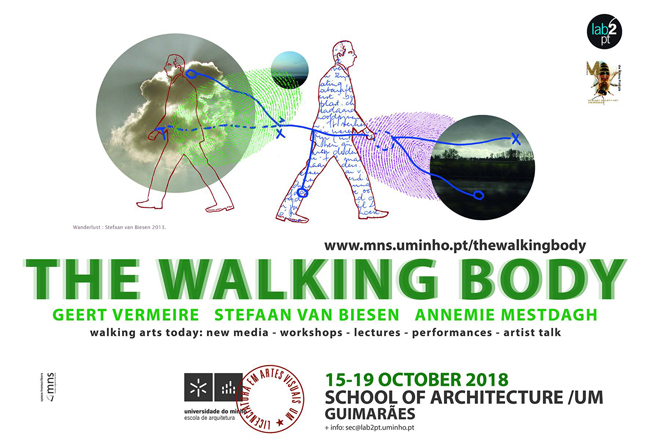
The meeting in Guimaraes anticipates the fifth international gathering Made of Walking which will have as a topic "The walking body" and will be held in Prespes National Park and in the village of Prespes, West Macedonia - Greece, on the border of Greece, Macedonia and Albania, beginning July 2019, as part of an international conference on arts and walking organized by the University of Western Macedonia - School of Fine Arts.
The event will be related to the interaction of the Body to Landscape (and vice versa); the artist or the cultural nomad interprets the Landscape as an open field where he/she obtains experiences and, through them, develops ideas, concepts and his/her artwork. A particular set of emotions is created during the experience of walking in the landscape and that shapes a characteristic venue of art expression.
Lectures / conferences in Guimaraes
Silent walking / augmented walking. Geert Vermeire talks about his practice in silent walks and sound walks, which he created in the last decade. Specifically, it elaborates on new approaches and new technologies, relating to the movement of the body, in particular with sound devices and mobile phones. Since last years, also extended to mobile video and augmented reality. In Portuguese.
[Meander III] performance/walk with the students, Minho University.
Concept by Stefaan van Biesen & Annemie Mestdagh.
Made of Walking / The Art of Walking in the Landscape. Geert Vermeire reviews the previous editions, which took place in Greece, Cyprus and France, defined by a participative approach by participants and inhabitants, collaboratively curated in a dialogue between h the coordinator / curator Geert Vermeire and invited international artists and conceptually framed by Dr. Simona Vermeire and referring to a recent scientific and aesthetic discipline, Spaziergangwissenschaft or Promenadology (Science of Walking), created in the 90s by the urbanist Lucius Burckhardt (Germany). In Portuguese.
Artist talk by Stefaan van Biesen. About his walking practice and how this relates to digital media, sound, drawings & performances. The oeuvre of Stefaan van Biesen departs from an associative solidity between thinking, acting, environment: ‘how do thoughts manifest themselves via acts in our environment, what extent do they contribute to our well-being?’. Stefaan van Biesen exhibited in Belgium, Holland, France, Germany, UK, Poland, Italy, Greece, Cyprus, Portugal, Brazil and China. Conference in English.
Workshops / performances in Guimaraes
Augmented walking (Geert Vermeire). Participants are introduced into methods of sound walking, recording and editing sound, with free software. Each participant creates a personal sound walk that can be immediately downloaded to their smartphone with the Locosonic application. The workshop includes recording environmental sounds during an introductory walk and incorporating sounds through the built-in editor interface, allowing you to search, navigate and use more than 100,000 existing sounds / recordings. The workshop will also include the design of a custom interface for the application, with text, a map and photographs and the immediate creation of a page witha description, a map, photographs and an online audio sample of the walk. https://www.locosonic.com/
Meander. (Stefaan van Biesen, Annemie Mestdagh) Walking is an instrument of knowledge and experience in the artistic work of Stefaan van Biesen. Concepts such as silence / time / body / mind, influenced by Eastern approaches, are situated in a Western way of thinking. Stefaan van Biesen invites you to a silent walk / performance: 'Meander' where concepts like 'turn on / let go / lead / trust / care' are the underlying ideas. In this constellation of influences (of feeling and being involved), the participant becomes, like the co-walker, the work of art! Concept and prop: Stefaan van Biesen and Annemie Mestdagh / the Milena principle. Outdoors. Duration: 45 minutes
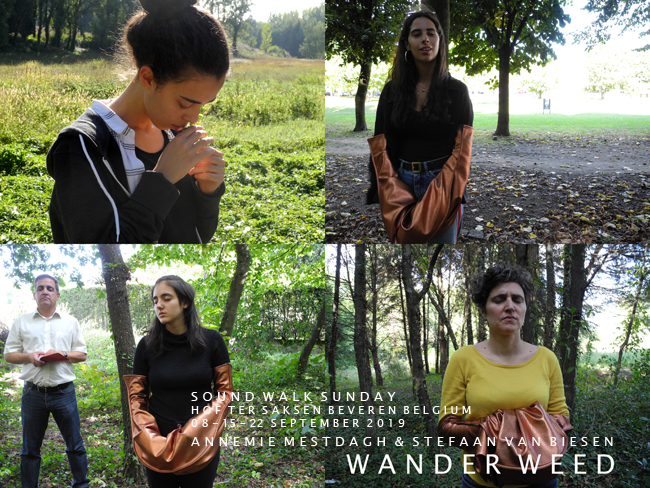
Wander Weed. (Stefaan van Biesen, Annemie Mestdagh) A performative walk with Stefaan van Biesen, where participants explore a nomad work of art on a shared walk with 5 people at a time, along the readings a of poetic letters by Stefaan van Biesen (Letters to a Tree). Production: Annemie Mestdagh. Concept: Stefaan van Biesen / the Milena principle. Outdoors.
http://www.mns.uminho.pt/thewalkingbody/
![]()
Plant(e)scape. Made of Walking (IV)Neon Chorio [Akamas Peninsula Cyprus] 29.06 < 08.07.2018.
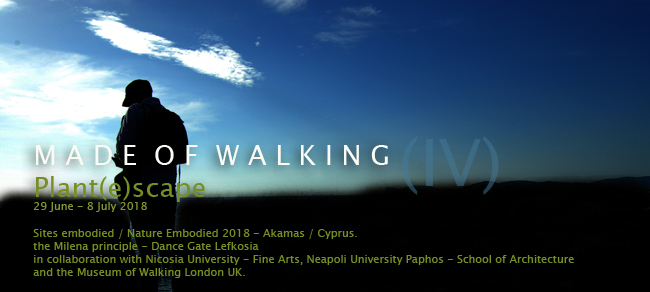
[Made of Walking IV] Sites embodied / Nature Embodied. Neo Chorio Akamas Cyprus 29.06 > 08.07.2018.
the Milena principle > Dance Gate Lefkosia in collaboration with Nicosia University > Fine Arts, Neapoli University Paphos > School of Architecture.
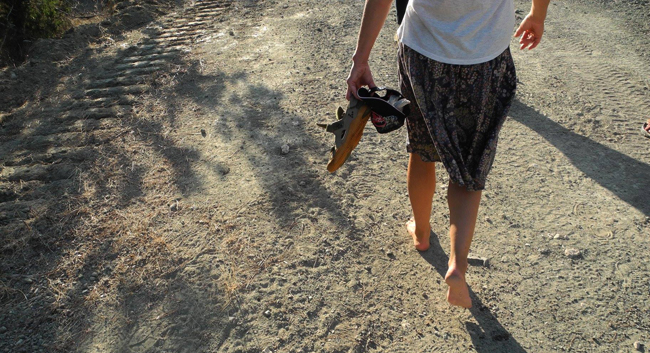
Theme of Made of Walking (IV) was Plant(e)scape, relating to human motion and emotion in a plenary botanical background, and combining walking as a creative instrument with two emergent sciences: Spaziergangwissenschaft (promenadology) and Critical Plant Studies (Vegetal Philosophy: Plant-Thinking). Promenadology is a "tool" to explore our everyday living environment, as well as for delivery of content and knowledge, in combination with Critical Plant Studies, considering the plants as living entities with their own consciousness, as thinking, sentient beings, not mere objects to be studied and classified; they are also agents in the production of meaning. Following the logic of a symbiotic being in the world, (shared by humans, animals and plants), where the anthropomorphic centrality is lost, we aim to recover a vegetal point of view and creating new ecological meanings that may deepen symbolic and aesthetic levels.

Selected and key note artists: Tracey M Berntsen (Australia), Ienke Kastelein (Holland), Lezli Rubin-Kunda (Canada/Israel), Rosie Montford (UK), Haris Pellapaisiotis (Cyprus), Panagiotis Lezes (Greece), Arianna Economou (Cyprus), Stefaan van Biesen (B), Annemie Mestdagh B), and Vermeire Geert (B).
![]()
[Wander Weed] The Language of Plants. Neon Chorio [Akamas Peninsula Cyprus] 29.06 < 08.07.2018.
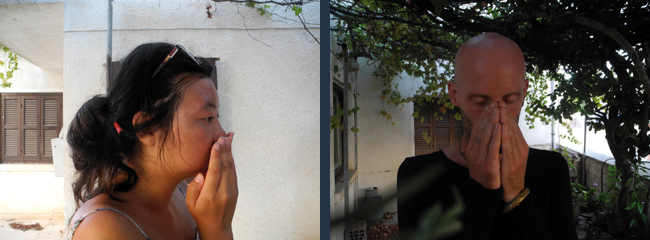
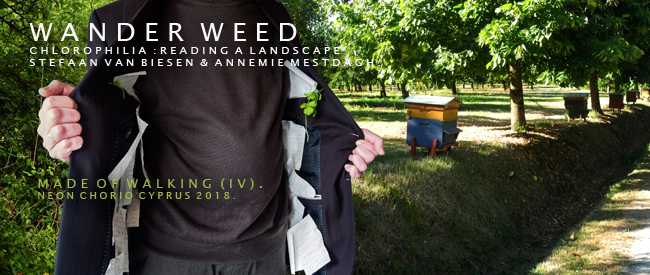
Wander Weed is a performative exercise about 'the language of plants' and connected to 'Letters to a tree' [1996-1997] by Stefaan van Biesen. You can only feel and touch 'the letters', not read them.
[We are Wander Weed: the language of plants]. How is our relation towards the green world? What can we learn from the natural world? Can we find guiding lines in the way plants behave? Will we be able to live with the knowledge that the world of mankind and plants are one? Do we accept that plants have a level of intelligence?
Many questions to be asked.
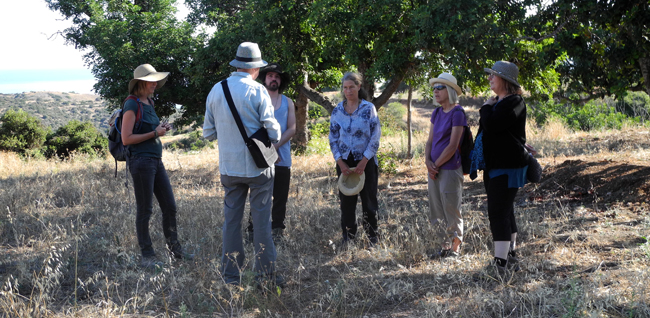
As a performative group the participants each get to use a nomadic art work, a prop/bag to walk with. Participants can feel a letter inside the bags. This letter contains leaves of plants selected by Stefaan van Biesen and Annemie Mestdagh from their own garden. So inside this letter directed to you, waits a gift, is included a surprise.
Curiosity, sense of touch and wonder are generated by this, accompanied by a talk by the artist about our relationship with plants, culture versus nature, and with the reading of letters (Letters to a Tree). At the end of the walk the participants are asked to smell their hands, now strongly aromatic because of the scented plants present, leading to introspection in their own past and personal memories. One hour activity, repeated in 3 groups of max 5 participants during the week of Made of Walking (IV) at Neo Chorio Akamas 2018.

The participants of the Wander Weed sessions were: Ienke Kastelein (NL), Annelies Vantygem (Belgium), Geert Vermeire (Belgium), Rosie Montford (UK), Tracey M Benson (Australia), Witold van Ratingen (NL), Panagiotis Lezes (Greece), Katarina Paisi (Cyprus), Sol Burton (UK/Cyprus), Lezli Rubun-Kunda (Israel/Canada), Gideon (Israel), Jen Martin (UK), Jacqui Orly (UK), Mark Durkan (Ireland) and Josefin Westborg (Sweden).
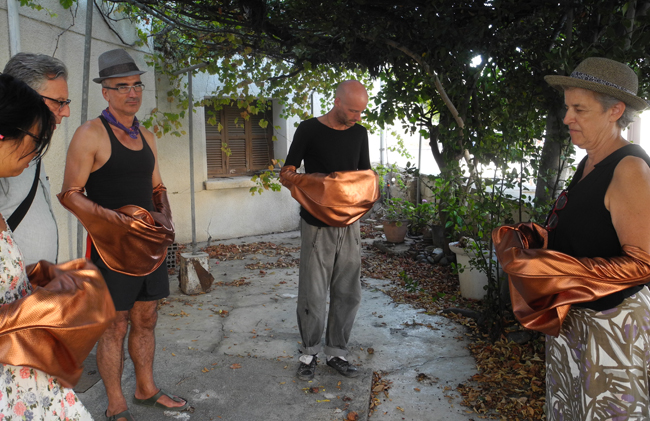
Photo: the thirth Wander Weed Variation session in an abandoned house in the centre of Neo Chorio.
![]()
[Wander Weed Variations] Video/perfromance Neon Chorio [Akamas Peninsula Cyprus] 08.07.2018.

Wander Weed Variations [Letters]. Made of Walking (IV) Neo Chorio Akamas Cyprus 2018. Letters kept in a copper colored fabric prop. Copper as the origin of the name 'Cyprus': one theory suggests that the large quantity of copper deposits on the island gave the name 'Cyprus', as copper has the Latin name of 'cuprum'. Copper [the Latin symbol: Cu] as a conductor, the Alchemic symbol of the goddess Aphrodithe [mythology: it proposes that the name 'Cyprus' was given by the goddess Aphrodite (also known as Kyprida) who was born on the island].
The video is taken in an abandoned house in Neo Chorio Akamas, a precious and still untouched nature reserve, gradually threatened by real estate companies. The echos of the past linger on between the stones, inside the ruins of the place. Voices are whispering the old songs.
Camera and prop performance by Annemie Mestdagh. Concept, video and sound composition by Stefaan van Biesen. Made of Walking is an international meeting of walking artists and scientists. Organised by Geert Vermeire / the Milena principle 2018. Time 05:52.
2017 > Made of Walking (III) La Romieu France.
![]()
[Box of Walks - Nomadic museum] Made of Walking ⋈ La Romieu France 27.08 > 01.09.2017.
The Box of Walks is an artifact of a nomadic museum of walks, that are displayed in situ for a limited time. It is taken in the luggage of the artist on the go and shown to the public when the opportunity arises.
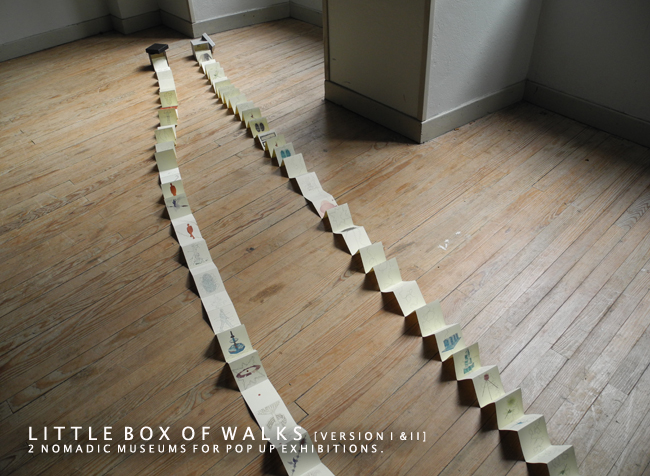
![]()
[Enter the Triangle] performance Made of Walking La Romieu France 27.08 > 30.08.2017.
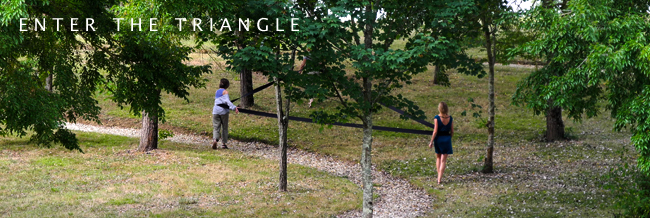
The Enter the Triangle performance (Silent Movements) is a gentle walking performance where three participants are required to listen to each other's body and the movements they make towards their own body. It is based on how to relate to another one's ways of moving or physical dialect: so to become aware of the other(s). At the same time to be aware of the urban environment and the fact that although you are connected, there is always a feeling of disconnection between you and the others. Being able to touch and still being in the distance. It can be seen as a mental exercise to trust the other(s). To follow the other moving bodies while moving in space and to become a moving shape of consciousness. A flow, a living human sculpture, constantly changing shape of a triangle by interactions.
Stefaan van Biesen. 'Enter the Triangle'. 27.08 > 30.08.2017. A silent meditative walk/performance for 3 walkers, during Made of Walking La Romieu 2017. With Annelies Vantyghem (Belgium), Niran Baibulat (Finland), Rosario Forjaz (Portugal), Andrew Stuck (UK), Mel Sutton (UK), Ivana Pinna (Italy/Spain), Guendouz Nawal (Algeria/france), Carol Mancke (USA), Phillip Mckenzie (UK), Leo Kay (Belgium/UK), Pam Patterson (Canada), Leena Raudvee (Canada), Ruth Roadbent (UK).
![]()
2017 > Made of Walking (II) Delphi Greece.
[Made Of Walking] Delphi Greece (15.07.2017 > 23.07.2017).
Link: https://animartgreece.eu/2017/en/events/13/
A project within the Animart Experiential Arts School and Forum of Contemporary Artists, the Milena principle organizes a forum with a series of walks and walking workshops, focussing on dialogues between performance, arts, literature and new media, inviting artists, writers, walkers, performers, musicians and composers, sound designers, new media artist, developers, teachers, researchers, experts and scientists of different fields, to share their experiences and to explore together topics related to walking practices. With contributors from the US, Canada, Australia, Singapore, South Africa, Egypt, Israel, India/France/UK, Portugal, Holland, Belgium, Turkey, Cyprus and Greece.

the Milena principle is an internationally operating platform and an artistic creation and research lab towards interdisciplinary practices within performance arts and new media, with a specific interest in the topics of ecology, sound, science, society and awareness.
Read the full program of Made Of Walking Delphi Summerschool Greece 2017.
![]()
[Enter the Triangle] Made of Walking (II). Animart Summer School. Delphi Greece [20.07 > 21.07.2017].
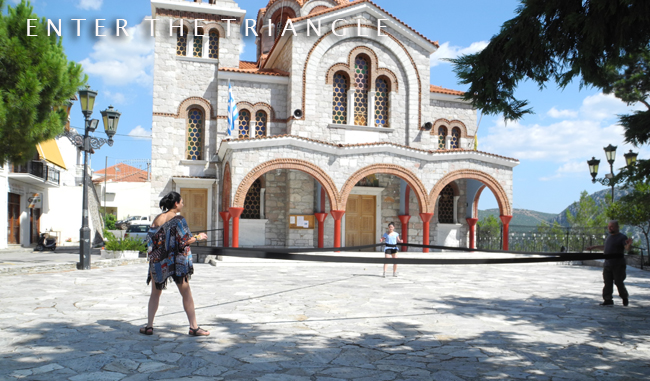
The Enter the Triangle performance [Silent Movements] is a gentle walking performance where three participants are required to listen to each other's body and the movements they make towards their own body. It is based on how to relate to another one's ways of moving or physical dialect: so to become aware of the other(s). At the same time to be aware of the urban environment and the fact that although you are connected, there is always a feeling of disconnection between you and the others. Being able to touch and still being in the distance. It can be seen as a mental exercise to trust the other(s). To follow the other moving bodies while moving in space and to become a moving shape of consciousness. A flow, a living human sculpture, constantly changing shape of a triangle by interactions.
Enter the Triangle. Interactive performance for 3 walkers and dancers during Made of Walking Delphi 2017. Concept and video: Stefaan van Biesen/the Milena principle. Attribute made by Annemie Mestdagh /the Milena principle. Performers: Lina Efstathiou (Greece), Eleni Nakou (Greece), Julia Redei (UK/Germany), Penny Finiri (Cyprus), Leand Kalaja (Albania), Panagiotis Lezes (Greece), Aliki Arnaouti (Greece), Ioanna Thanou (Greece), Chara Tzoka (Greece), Marianna Makri (Greece), Vermeire Geert (Belgium) and Haris Pellapaisiotis (Cyprus).
![]()
[Silencer / Monochord] Made of Walking (II). Delphi Greece (15.07.2017 > 23.07.2017).
A project based on the last request of Pythagoras while dying: "Play the monochord for me'.
An instrument for Delphi: the place shapes the sounds.
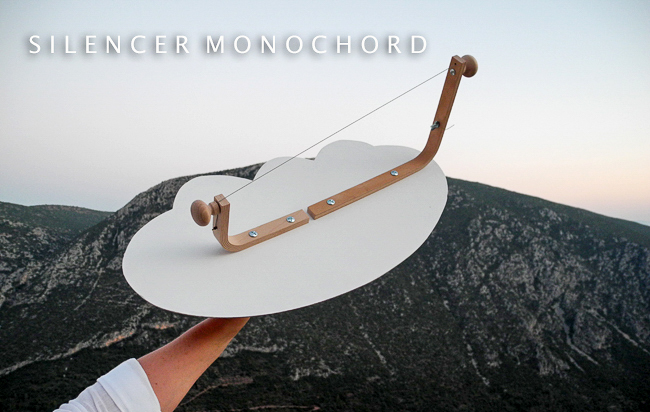
Consonance and dissonance. Pythagoras conceived the universe to be an immense monochord. Instruments derived from the monochord (or its moveable bridge) include the guqin, dan bau, koto, vina, hurdy-gurdy, and clavichord ("hence all keyboard instruments"). Harmony is a state recognized by great philosophers as the immediate prerequisite of beauty. A compound is termed beautiful only when its parts are in harmonious combination. The world is called beautiful and its Creator is designated the Good because good perforce must act in conformity with its own nature; and good acting according to its own nature is harmony, because the good which it accomplishes is harmonious with the good which it is. Beauty, therefore, is harmony manifesting its own intrinsic nature in the world of form.
A monochord, also known as sonometer, is an ancient musical and scientific laboratory instrument, involving one (mono) string (chord). The term monochord is sometimes used as the class-name for any musical stringed instrument having only one string and a stick shaped body, also known as musical bows. According to the Hornbostel–Sachs system, string bows are bar zithers while monochords are traditionally board zithers. The 'harmonical canon', or monochord is, at its least, "merely a string having a board under it of exactly the same length, upon which may be delineated the points at which the string must be stopped to give certain notes," allowing comparison.
A string is fixed at both ends and stretched over a sound box. One or more movable bridges are then manipulated to demonstrate mathematical relationships among the frequencies produced. "With its single string, movable bridge and graduated rule, the monochord (kanōn [Greek: law]) straddled the gap between notes and numbers, intervals and ratios, sense-perception and mathematical reason." However, "music, mathematics, and astronomy were [also] inexorably linked in the monochord."
![]()
[The Colour You Are] Made of Walking (II). Delphi Greece (15.07.2017 > 23.07.2017).
Appendix of the 'Silencer / Monochord' project.
A total sensorial experience of our environment is only possible if all our senses are redefined in a harmonious perception and 're-fine-tuned' by a ' feeling thinking / feeling thinking'. Color, smell, sound, feelings, are a (higher or lower) octave of each other. On one long imaginary string, they flow from one to the other. All these stimuli and sensations are a manifestation of vibration (or frequencies) at different levels. In this way, the color 'red' is another harmonic manifestation of the tone 'do'. A Scent Of Silence is an exercise in resonance, the awareness that we are more than just 'form'. Everything in the universe is reducible to a number and frequency and is related to each other. We are sensible moving color and sound.
During this sensory walking workshop we allow walkers to meet with their individual 'tone' and 'color(s)'. We will use the colors that were defined by the great Russian tone poet and composer Aleksandr Scriabin (1872-1915) (as a homage to this extraordinary musician), who emphasized the strong relationship between tone and color into his own musical compositions.
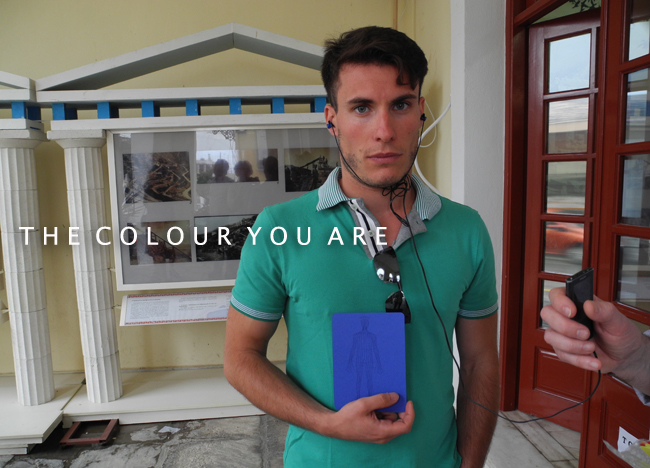
Starting from the Shen Dao system of each person's neutral base color (personalized and determined by year of birth, and linked to the nourishing, soothing, controlling, draining colors and their functions) in relation to the 5 elements.
W A L K S : the urban flaneur
![]()
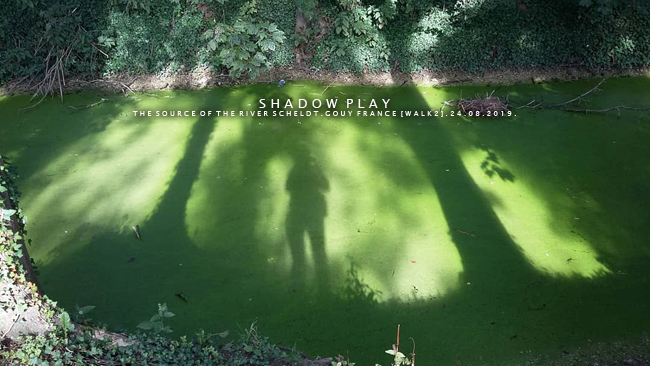
'not all of those who wander are lost'. [photo below: Annemie Mestdagh 2019]
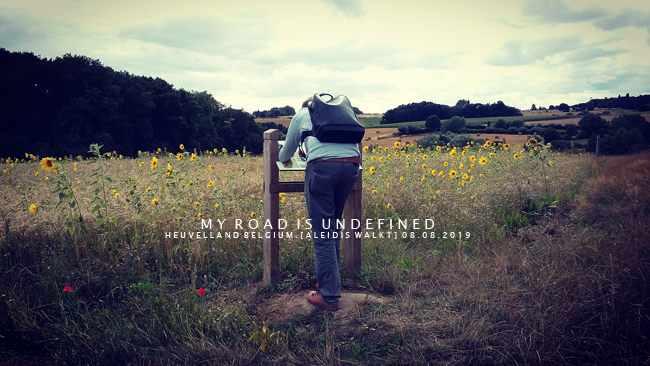
Spaziergangwissenschaft [ An everyday practice].
Stefaan Van Biesen is a Belgian visual artist, multimedia artist, sound artist and writer. His oeuvre is focused on the research of walking as an instrument of knowledge and of artistic creation. An artistic trajectory of more then 20 years consists out of walks, drawings, projects, installations, videos, perfomances, texts and soundscapes, developed as an interactive process, a stream of ideas, images, sounds and visions in which collaborations with other artists, experts from various disciplines and community based artistic processes are important components.

Since 1990 Stefaan van Biesen undertakes, at home and abroad, walks, which, by way of performance, he documents with video, pictures, models, texts, drawings. The Swiss sociologist and urbanist, Lucius Burckhardt [1925-2003] introduced in the nineties the concept: 'Spaziergangwissenschaft'. Stefaan van Biesen wanted to expand this 'science of walking'. It can be seen as a subjective thought exercise in the urban texture and the landscape, ['Head Wanderer' 2002]. This resulted in 'Sensitive islands' where social observations from an unbiased position were recorded. Thus arose in various libraries 'Libraries of the Walks' [the most recent was seen in Brasilia 2012, [Jardim Botanico, Brazil]. The core remains a question, an invitation to the 'art of wandering', where the destination is secondary to the road itself. The day as a cycle of meetings, the body as a moving center, instrument of knowledge, experience and creativity.
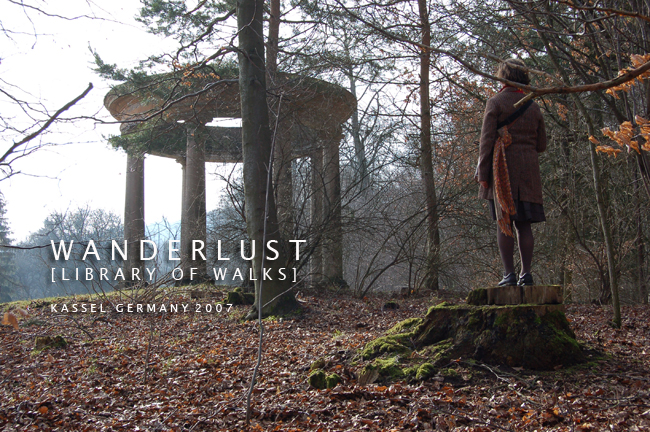
Stefaan van Biesen plays an important role in this 'science of walking': he examines it in an aesthetic way, documented with installations, performances, multimedia, drawings. His work has a strong affinity with the work of another famous 'walker': Fernando Pessoa. Van Biesen's thinking is in line with the nomadic aspect of the Renaissance artists who traveled all over Europe. Dürer is a striking example of this. These journeys were art projects, in which currents of thoughts, drawings and other artifacts arose out of encounters with other people and cultures. These trips were, as it were, laboratories of thought. Van Biesen shows this lab. Notes, artifacts and drawings upholster his journey. Walks are traces of memory, as an ecological gesture, an invitation to wander.
![]()
1992 > the first registrated walks.
[My load is undefined/ Onbestemd is mijn vracht] [video 1992]. The registration of a 2 days walk. A walking performance on several locations in Flanders Belgium. Video/production made by my fellow walker: Toon Sarens.
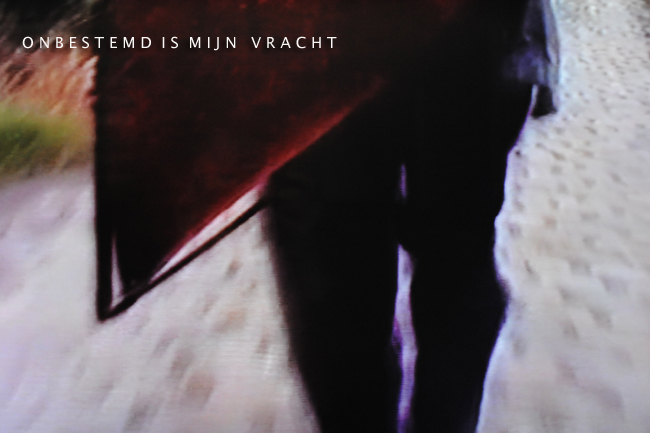
[My load is undefined] My first walk as the start of an artistic practice: registration of a two days walk in the Flemish landscape: Melsele Belgium 1992. Attribute Stefaan van Biesen. An homage to Breugel and Bosch. Camera and video by Toon Saerens. Time 04:46.
![]()
[Blind Walk] The Book I Am. Melsele 1992.
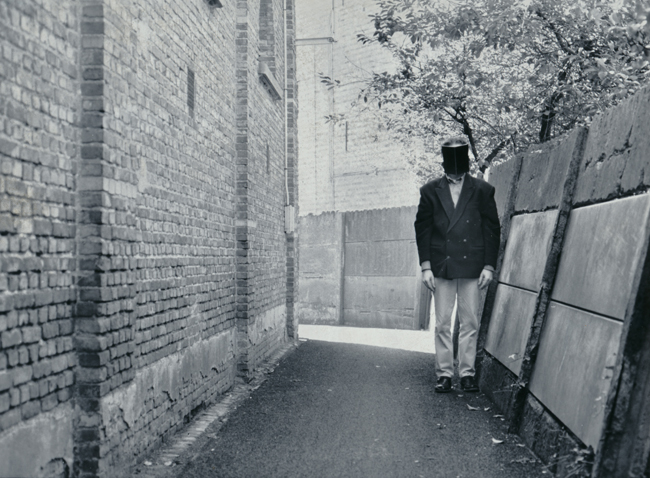
B L I N D W A L K [T H E B O O K I A M . 1 9 9 2 ] .
Silent walking performance Melsele Belgium. A quiet walk in my own living environment, in places that will disappear with the arrival of new buildings and houses. The transformation of a rural village swept up by the big city. A silent goodbye to the echoes of the past.
![]()
Walks > an everyday practice > an inspiration:
[Since 1990]
Method I: broadly documented walks > research in the urban human space > walks as a sensory experience > which through documentation have a scientific and aesthetic layer.
In 2005 Ingrid Pee (former assitant of Joseph Beuys during the 7000 Oak project in Kassel Documenta Germany) introduced us to the concept of 'Spaziergangwissenschaft', which was introduced in the 1990s at the University of Kassel, Germany, by the Swiss sociologist and urbanologist Lucius Burckhardt (1925-2003). Walking elevated to an observing stimulus in relation to space. It perfectly matched my work and thinking. It was a revelation and it gave a nice feeling to see that my work fit in with an artistic tradition, a large family of predecessors.
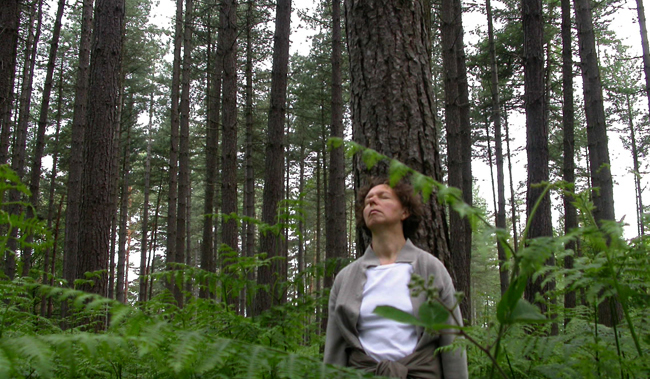
Method II: between 2000 and 2004 > members of 'Bewust Wandelen' [Walking Consciously] > the concept of geomancy > a small alternative group of artists, writers and therapists, under the inspired wings of Kris Tolomei, who regularly organized lectures and walks at energetic places in Belgium and Holland. Photo: Annemie Mestdagh during a sensorial walk in the Zoniënwoud near Brussels with a large group organized by Joel Libert.

During this period, a cross-pollination has become the foundation of the work of Stefaan van Biesen: an urban flaneur that allows art to emerge from observation. Life as a cycle of encounters with people, situations, places, buildings, the natural and animal world, a conversation with trees since childhood days. A rich breeding ground as an artist.
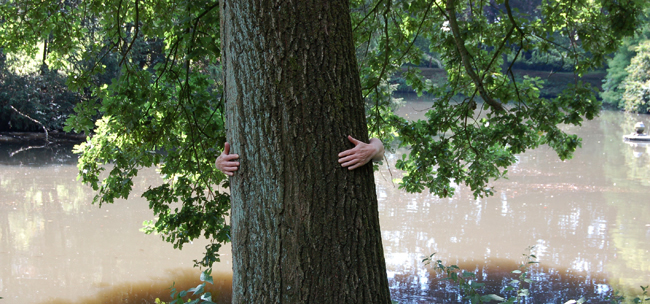
Axis Mundi. During the walks we embraced trees. We also stood on the remains of shopped off trees as an ecological comment, a small natural 'speakers stage' > so holding a speech or reading a letter. Trying to imagine how the tree looked like when he was whole. To be aware, trying to feel and to become the tree, imagine his presence and energy. Photo: embracing trees.
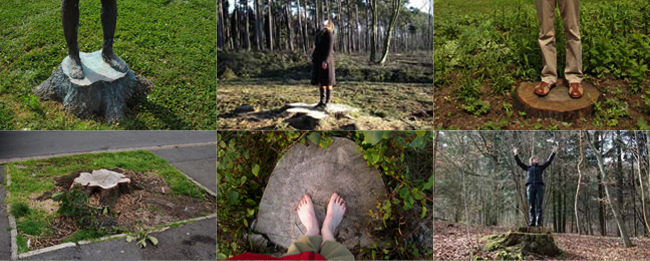
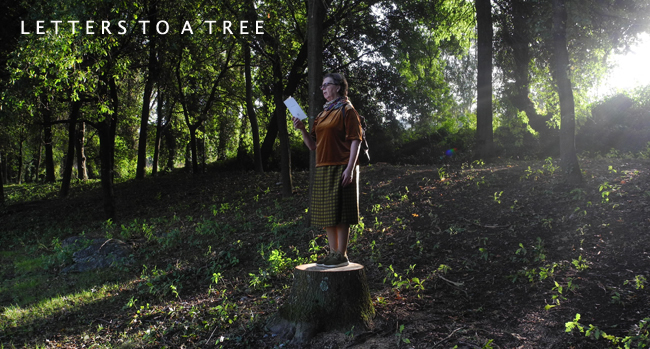
![]()

'In the work of Stefaan van Biesen an associative solidity has arisen between thinking, acting, environment and well-being. Formulated as a question: 'how do our thoughts manifest themselves via acts in our environment and to what extent do they contribute to our well-being?' (Stef Van Bellingen, 2006).
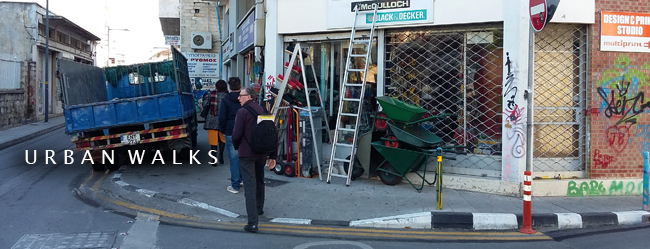
The body is experienced as an influential instrument, a subject that feels out its environment and resonates out of a sensitive thinking. The body thus moves in an optical and emotional field out of a panoramic perspective, a sanctuary.
![]()
Breeding grounds for artistic reflections

Chronicle of the urban walker
'The flaneur walks in the city's hustle and bustle as a devoted observer, who with great excitement absorbs everything in order to try to understand life and to wonder. In the midst of all urban activity he solves and becomes one with the city he has become.
The flaneur feels at home everywhere. His true 'home', however, is his body. A silent person that walks through squares and streets. It's an important and necessary feeling to want to know the world and to see it, always with other eyes. To be carried away completely and the same time to hide yourself visibly. The will to be that coincidental passant, a croniqeur incognito. The desire to refine all life art to taste full life as a shivering fish in the expanding universe. This vacuum of nourishing energy, flowing from the centuries-knocking heart of the city. And this is what makes us come home.'
Stefaan van Biesen

Modern cities have often forgotten how to listen to walking and the needs of people who are walking. With a focus on two questions, interspersed with short walks. How can the ideas of listening to walking and listening while walking be brought into the day-to-day worlds of city planning and design? How can the worlds of art and walking advocacy work together to help communities get the mix of physical and spiritual walking space that they need to make healthier and happier places?
Walking is low impact, requires minimal equipment, can be done at any time of day and can be performed at your own pace. You can get out and walk without worrying about the risks associated with some more vigorous forms of exercise. Walking is also a great form of physical activity for people who are overweight, elderly, or who haven’t exercised in a long time. Walking is sociable, improving our sense of community.
![]()
Wanderlust > a tribute to previous walkers.
Walking Talking interview by Andrew Stuck [Museum of Walking London UK] 2019.

[Talking Walking] Made of Walking ⋈ La Romieu France 27.08 > 01.09.2017.
Delighted to say that Andrew Stuck [Museum of Walks London Uk] has got around in 2019 to editing the Talking Walking interview with me in the summer of 2017 in La Romieu during Made of Walking (III). A pod cast made by Andrew
during a walk with him. A walking talk about work and art in relation to my 'Library of Walks' and 'Letters to a Tree'. Listen here:
https://www.talkingwalking.net/stefaan-van-biesen-talking-walking/
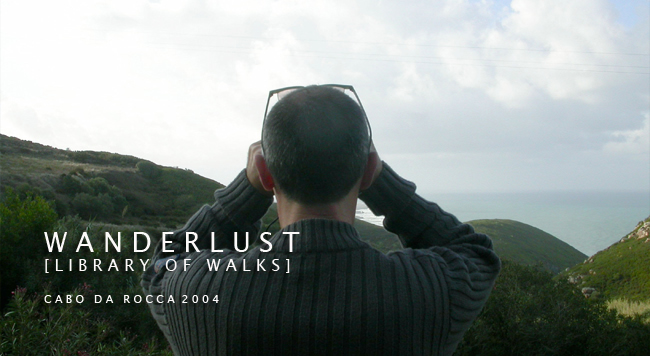
Wanderlust. An hommage to Caspar David Friedrich. [1774-1840].
Letter: Thoughts of a coincidental walker (in a city park).
'The black bird above me knows that the evening is falling. It croaks its dissatisfaction and then flies away, far from the place where I stand. It is like a little rascal who tries to chase me away. I know it is there, hidden between the foliage, waiting for me to leave. It sees me as an uninvited guest in its sunroom and claims this spot. A soft tangle of countless weak noises makes it clear that I am not alone on this path. I am a walker with an inward turned ear, listening to the beat of my heart, and to how my lungs fill up with air and release it after every breath I take. A body that sways like a feather, a vibrating string in a big sound box named world. A strange kind of music appears out of nothingness.
It sounds like humming, the buzzing of a dancing bee in its hive. The throat, a shaft of noises, through which everything has to be shoved. And it fades away through the thin layers of air around me. Words, which dissolve into nothingness, thoughts which keep spinning around in your head.
Whispering is nothing more than careful listening to oneself.'
Stefaan van Biesen.

![]()
Passages
Documenting walks over the years.
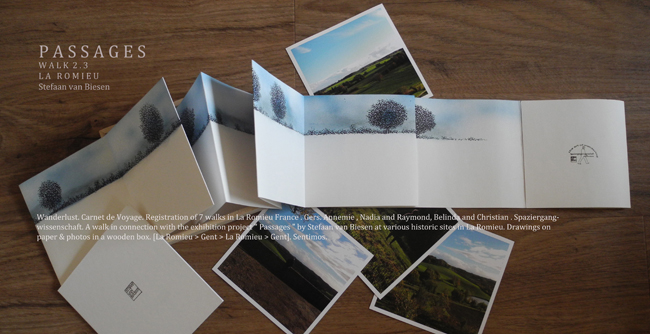

[Sketchbook walks Urban Emptiness] Stefaan van Biesen & Geert Vermeire Edinburgh Scotland 2016.